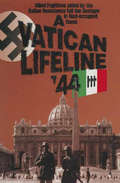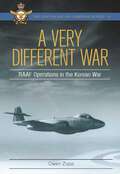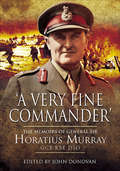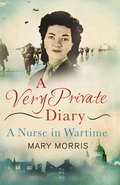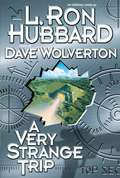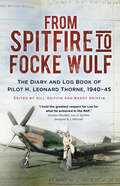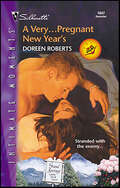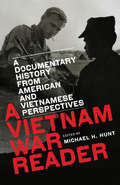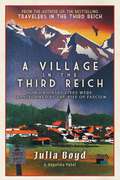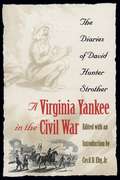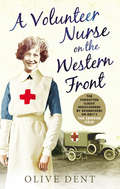- Table View
- List View
A Vast Sea of Misery: A History and Guide to the Union and Confederate Field Hospitals at Gettysburg, July 1–November 20, 1863
by Gregory Coco“An extremely detailed history of 160 hospital sites that formed to care for soldiers who were wounded at the Battle of Gettysburg.” —Civil War CyclingNearly 26,000 men were wounded in the three-day battle of Gettysburg (July 1-3, 1863). It didn’t matter if the soldier wore blue or gray or was an officer or enlisted man, for bullets, shell fragments, bayonets, and swords made no class or sectional distinction. Almost 21,000 of the wounded were left behind by the two armies in and around the small town of 2,400 civilians. Most ended up being treated in makeshift medical facilities overwhelmed by the flood of injured. Many of these and their valiant efforts are covered in Greg Coco’s A Vast Sea of Misery.The battle to save the wounded was nearly as terrible as the battle that placed them in such a perilous position. Once the fighting ended, the maimed and suffering warriors could be found in churches, public buildings, private homes, farmhouses, barns, and outbuildings. Thousands more, unreachable or unable to be moved remained in the open, subject to the uncertain whims of the July elements. As one surgeon unhappily recalled, “No written nor expressed language could ever picture the field of Gettysburg! Blood! blood! And tattered flesh! Shattered bones and mangled forms almost without the semblance of human beings!”Based upon years of firsthand research, Coco’s A Vast Sea of Misery introduces readers to 160 of those frightful places called field hospitals. It is a sad journey you will never forget, and you won’t feel quite the same about Gettysburg once you finish reading.
A Vatican Lifeline '44: Allied Fugitives aided by the Italian Resistance foil the Gestapo in Nazi-occupied Rome
by William SimpsonA memoir of an Allied soldier and former POW in Rome, and the unexpected support he received from the Italian people—and from a heroic Catholic monsignor. It is a widely held belief that the Italians in the Second World War failed to win much in the way of martial glory. But the scoffers tend to overlook the fact that most Italians had little or no feeling of animosity toward the Allies—and to wage war against an enemy with whom you have no quarrel is a contradiction in terms. This contradiction is vividly portrayed in William Simpson&’s dramatic account of his time in Rome after the downfall of Mussolini and Italy&’s withdrawal from the war in September 1943, when thousands of Allied prisoners of war, let loose in surrendered Italy, fell prey to occupying Nazi forces. Simpson, an escaped POW, managed, after some hair-raising adventures, to find his way to Rome and soon discovered how widespread was the support of the Italians for the Allies, and how deep-seated their hatred of the Nazis. His adventures during the months before the Allies finally liberated Rome, helping to house and feed hundreds of Allied prisoners on the run, make for compulsive reading—and leave no doubt about the extraordinary bravery of the many Italians who came to their aid. But the real hero of this dramatic story is Monsignor O&’Flaherty, who, with remarkable sangfroid, used the somewhat precarious neutrality of the Vatican, where he was employed, to help Simpson and his fellow fugitives.
A Very Different War: RAAF Operations in the Korean War
by Owen ZuppThe Korean War lies between the enormity of the Second World War and the controversy of Vietnam. Although it often slips through the cracks of history, it represented a global shift as two opposing ideologies clashed and the Cold War heated up. The fledgling United Nations was called to act, and Australia joined the 21 nations committed to supporting South Korea. Within days of the North Koreans crossing the 38th Parallel, the RAAF was flying missions from its base in Japan. In the ensuing three years, the RAAF gained respect among its peers and the attention of the opposing military powers. When the war reached a crisis point, with UN forces pinned down and threatened with being pushed off the peninsula into the sea, the RAAF was at the epicentre. During the war, the RAAF entered the jet age, and the transition was not without challenges and losses. Ultimately, a generation of RAAF leaders emerged from the ranks of sergeant pilots and junior officers who underwent their baptism of fire on the Korean Peninsula. Using No 77 Squadron operations as a timeline, this concise history of the RAAF involvement in the war examines the roles of the transport unit, nurses, ground crews, prisoners of war and those who still have no known resting place.
A Very Fine Commander': The Memories of General Sir Horatius Murray GCB KBE DSO
by John DonovanThe contrast between soldiering in peace and war is well illustrated by Nap Murrays experiences. It took him 16 years to reach the substantive rank of Major in 1938 but by 1944 he was an acting Lieutenant General.His fascinating memoirs, skillfully edited by his nephew, cover an extraordinary career from young officer service in India, China and Egypt, his experiences with the German Army in 1937 before the dramas of WW2. His accounts of action and injury in the early war years in France, North Africa, Sicily and Normandy, prepare the reader for Murrays long and distinguished record as a Divisional commander in Italy, Palestine, Catterick and finally the Commonwealth Division in Korea. It was Monty himself who described Murray as A Very Fine Commander praise indeed, a memoir can be very revealing about the character of its author. Entirely free of self-aggrandisement or pride this book leaves the reader unsurprised at the success and popularity of its author.
A Very Long Engagement
by Sebastien JaprisotSet during and after the First World War, A VERY LONG ENGAGEMENT is the tale of a young woman's search for her fiance who she believes might still be alive despite having officially been reported as "killed in the line of duty." Unable to walk since childhood, fearless Mathilde Donnay is undeterred in her quest as she scours the country for information about five wounded French soldiers who were brutally abandoned by their own troops. A VERY LONG ENGAGEMENT is a mystery, a love story, and an extraordinary portrait of life in France before and after the War.
A Very Principled Boy: The Life of Duncan Lee, Red Spy and Cold Warrior
by Mark A. BradleyDuncan Chaplain Lee was an unlikely traitor. A Rhodes Scholar, patriot, and descendent of one of America’s most distinguished families, he was also a communist sympathizer who used his position as aid to intelligence chief #147;Wild Bill” Donovan to leak critical information to the Soviets during World War II. As intelligence expert Mark A. Bradley reveals, Lee was one of Stalin’s most valuable moles in U. S. intelligence, passing the KGB vital information on everything from the D-Day invasion to America’s plans for postwar Europe. Outwitting both J. Edgar Hoover and Senator Joseph McCarthy, he escaped detection again and again, dying a free man before authorities could prove his guilt. A fast-paced cat-and-mouse tale of misguided idealism and high treason, Perry's book draws on thousands of previously unreleased CIA and State Department records to reveal the riveting story of one of the greatest traitors of the twentieth century.
A Very Private Diary: A Nurse in Wartime
by Mary Morris'Mary is a talented writer and a humane observer of her remarkable experiences. Her diary is full of vivid, sometimes shocking vignettes ... [A] fascinating and deeply moving book' DAILY MAIL'We know so much about Mary's war because she broke the rules. Keeping a diary was strictly forbidden while on active service, which makes Mary's remarkably complete account all the more exceptional' DAILY EXPRESSThe newly discovered diary of a wartime nurse - a fascinating, dramatic and unique insight into the experiences of a young nurse in the Second World War.'I always seem to be saying good-bye to men whom I might have loved had there been enough time...'1939: 18-year-old trainee nurse Mary Mulry arrives in London from Ireland, hoping for adventure. Little did she know what the next seven years would bring.In her extraordinary diary, published now for the first time, Mary records in intimate detail her life as a nurse, both on the Home Front and on the frontline. From nursing children during bombing raids in London to treating Allied soldiers in Normandy, Mary's experiences gave her vivid and unforgettable material for the private diary she was dedicated to keeping.Filled with romance, glamour and inevitably sadness, too, these are the rich memories of an irrepressible personality, living through the turbulent years of the Second World War.
A Very Private Diary: A Nurse in Wartime
by Mary MorrisMary Mulry was eighteen years old when she arrived in London from Ireland to begin training as a nurse. The year was 1939. She had hoped for an adventure and a new start; she could not have predicted what the next seven years would bring.In this extraordinary diary Mary recorded in intimate detail her experiences as a nurse on the Home Front and later working on the frontline in Europe. In London, she nursed critically ill children during bombing raids and narrowly escaped with her life in one the worst nights of the Blitz. In Normandy, arriving on the heels of the D-Day invasion, she tended to Allied soldiers and German prisoners of war. In war-torn Belgium, she witnessed harrowing casualties from the Battle of Arnhem.Yet romance, glamour and adventure were never far away for Mary, even if her relationships often had to be cut short. 'I always seem to be saying good-bye to men whom I might have loved had there been enough time,' she writes.Nurses were not allowed to keep diaries on active service, but Mary - fortunately for us - was not one for following rules. Her rebellious spirit, sharp wit and irrepressible personality shine through the pages of her 'very private diary', published now for the first time.Read by Lara Hutchinson(p) 2014 Orion Publishing Group
A Very Strange Trip
by L. Ron HubbardBoldly go to times where no one has gone before. While transporting a contraband Russian time machine and developmental weaponry, Private Everett Dumphee finds himself cast into new settings when the device suddenly activates. What follows are fantastic high-tech experiences that might be called the ultimate off-road adventure. For the determined Dumphee - narrowly escaping with his life and three beautiful women - it is not necessarily a matter of will he make his destination, but when. These four vivid characters trek through this fun and fast-moving journey like there's no tomorrow. Wherever that may be. "A wild, high-tech ride through time. Read it to have a rollicking good time." --Brian Herbert, co-author "Dune: House Attreides"
A Very Unusual Air War: From Dunkirk to AFDU: The Diary and Log Book of Test Pilot H. Leonard Thorne, 1940-45
by H. Leonard Thorne Gill Griffin Barry GriffinIn May 1940, 20-year-old Len Thorne joined the RAF, as did many young men during the Second World War. After two hectic tours of operational duty as a fighter pilot, including some desperately dangerous low-level flying at Dunkirk, he was posted to AFDU (Air Fighting Development Unit) and remained there as a test pilot for the rest of the war.Fortunately for us, Len kept a detailed diary, which, set alongside his log book, tells the unique story of a test pilot tasked with developing operational tactics and testing captured enemy aircraft, such as the feared Fw 190. During Len's career, he worked alongside some of the most famous fighter aces and his records cast light on some of the most famous flyers of the RAF, including Wing Commander Al Deere and Spitfire aces Squadron Leader ‘Paddy’ Finucane, Ernie Ryder and many others.A unique record of military aviation history, From Spitfire to Focke Wulf offers a window to this era of rapid and high-stakes aircraft development.
A Very . . . Pregnant New Year's (36 Hours)
by Doreen RobertsFAMILIES FEUD ON NEW YEAR’S EVE…A GIANT AVALANCHE STRIKES…TWO ENEMIES ARE TRAPPED IN A SNOWBOUND CABIN…When fate stranded them together, Anne Parker fought her attraction for roguish Brad Irving. She couldn’t possibly want this scoundrel—her father’s sworn enemy, breaker of hearts. Until…uh-oh! She’d just made love with the one man in the world she shouldn’t have. Yet never in her life had she felt such fierce desire as she felt now for Brad. And soon a baby was on the way… Would their child be raised a Parker or an Irving? Or was this finally the truce they were looking for?
A Vietcong Memoir
by Truong Nhu Tang David Chanoff Doan Van ToaiThis book recounts the experiences of a non-Communist participant in the Vietnamese national resistance to foreign domination, as urban organizer and participant in the NLF, and the author's feelings of betrayal by the Communists.
A Vietnam Experience: Ten Years of Reflection
by James B. StockdaleThe decade that followed James Stockdale's seven and a half years in a North Vietnamese prison saw his life take a number of different turns, from a stay in a navy hospital in San Diego to president of a civilian college to his appointment as a senior research fellow at the Hoover Institution. In this collection of essays he offers his thoughts on his imprisonment. Describing the horrors of his treatment as a prisoner of war, Stockdale tells how he discovered firsthand the capabilities and limitations of the human spirit in such a situation. As the senior officer in confinement he had what he humbly describes as "the easiest leadership job in the world: to maintain the organization, resistance, and spirit of ten of the finest men I have ever known." His reflections on his wartime prison experience and the reasons for his survival form the basis of the writings reprinted here. In subject matter ranging from methods of communication in prison to military ethics to the principles of leadership, the thirty-four selections contained in this volume are a unique record of what Stockdale calls a "melting experience"—a pressure-packed existence that forces one to grow. Retired Vice Admiral James B. Stockdale, a Hoover Institution fellow from 1981 to 1996, was Ross Perot's 1992 presidential running mate and a recipient of the Medal of Honor after enduring seven and a half years as a prisoner of war in North Vietnam. He died in 2005 at the age of 81.
A Vietnam War Reader
by Michael H. HuntAn essential new resource for students and teachers of the Vietnam War, this concise collection of primary sources opens a valuable window on an extraordinarily complex conflict. The materials gathered here, from both the American and Vietnamese sides, remind readers that the conflict touched the lives of many people in a wide range of social and political situations and spanned a good deal more time than the decade of direct U.S. combat. Indeed, the U.S. war was but one phase in a string of conflicts that varied significantly in character and geography. Michael Hunt brings together the views of the conflict's disparate players--from Communist leaders, Vietnamese peasants, Saigon loyalists, and North Vietnamese soldiers to U.S. policymakers, soldiers, and critics of the war. By allowing the participants to speak, this volume encourages readers to formulate their own historically grounded understanding of a still controversial struggle.
A View from the Stands
by John Kenneth GalbraithIn the decades since World War II, no American writer has done more to comfort the afflicted and afflict the comfortable than John Kenneth Galbraith. Galbraith reflects on many famous people, including Mencken, Hemingway, O'Hara, Muggeridge, Buckley, and more.
A Village in the Third Reich: How Ordinary Lives Were Transformed by the Rise of Fascism
by Julia Boyd Angelika PatelAn intimate portrait of German life during World War II, shining a light on ordinary people living in a picturesque Bavarian village under Nazi rule, from a past winner of the Los Angeles Times Book Prize for History.Hidden deep in the Bavarian mountains lies the picturesque village of Oberstdorf—a place where for hundreds of years people lived simple lives while history was made elsewhere. Yet even this remote idyll could not escape the brutal iron grip of the Nazi regime. From the author of the international bestseller Travelers in the Third Reich comes A Village in the Third Reich, shining a light on the lives of ordinary people. Drawing on personal archives, letters, interviews and memoirs, it lays bare their brutality and love; courage and weakness; action, apathy and grief; hope, pain, joy, and despair. Within its pages we encounter people from all walks of life – foresters, priests, farmers and nuns; innkeepers, Nazi officials, veterans and party members; village councillors, mountaineers, socialists, slave labourers, schoolchildren, tourists and aristocrats. We meet the Jews who survived – and those who didn&’t; the Nazi mayor who tried to shield those persecuted by the regime; and a blind boy whose life was judged "not worth living." This is a tale of conflicting loyalties and desires, of shattered dreams—but one in which, ultimately, human resilience triumphs. These are the stories of ordinary lives at the crossroads of history.
A Virginia Yankee in the Civil War
by Cecil D. EbyThe Civil War diaries of David Hunter Strother, known better to his contemporaries as "Porte Crayon," chronicle his three years of service in the Union army with the same cogency and eye for detail that made him one of the most popular writers and illustrators in America in his time. A Virginian strongly opposed to secession, Strother joined the Federal army as a civilian topographer in July of 1861 and was soon commissioned, rising eventually to the rank of brigadier general. He served under a succession of commanders, including Generals Patterson, Banks, Pope, and McClellan, winning their respect as well as their confidence. First published by UNC Press in 1961, A Virginia Yankee in the Civil War is a fascinating firsthand record of the conflict and of the divided loyalties it produced that is further enlivened by Strother's remarkable humor and insight.
A Visit to Three Fronts June 1916: June 1916 (world Classics, Unabridged) (The World At War)
by Arthur DoyleThe book is a glorious effort on the part of the author to record the impressions that he formed during his visit to the fronts of the Western Allies during World War I. The book was written in appreciation of the valiant and bold soldiers who fought for their countrymen and whose efforts were being belittled due to increasing rumours. (Excerpt from Goodreads)
A Visitor's Guide to Jane Austen's England (A Visitor's Guide #2)
by Sue Wilkes&“Wilkes makes the world of Jane Austen come to life . . . from travel to fashion, shopping, leisure, and, of course, finding a mate&” (Britain Express). Immerse yourself in the vanished world inhabited by Austen&’s contemporaries. Packed with detail and anecdotes, this is an intimate exploration of how the middle and upper classes lived from 1775, the year of Austen&’s birth, to the coronation of George IV in 1820. Sue Wilkes skillfully conjures up all aspects of daily life within the period, drawing on contemporary diaries, illustrations, letters, novels, travel literature, and archives. Were all unmarried affluent men really &“in want of a wife&”?Where would a young lady seek adventure?Would &“taking the waters&” at Bath and other spas kill or cure you?Was Lizzy Bennet bitten by bed-bugs while traveling?What would you wear to a country ball or a dance at Almack&’s?Would Mr. Darcy have worn a corset?What hidden horrors lurked in elegant Regency houses? &“A delight. I don&’t think I&’ve ever read a book that paints such a vivid picture of daily life in late 18th and early 19th century England. It makes a perfect companion for Austen&’s beloved novels.&” —The Heritage Traveller &“A thoroughly engaging—and very informative—&‘eyewitness&’ guide to everything from medical matters to modes of travel.&” —Joceline Bury, Jane Austen&’s Regency World &“Written as if to a first-time traveler in the Regency . . . an inviting read . . . a perfect gift for every Janeite friend and family member.&” —Austenprose &“A worthy contribution to the field of Austen social history and uses the mundane realities of life to illuminate the reader&’s experience.&” —Sensibilities
A Voice From Harper's Ferry
by Osbourne P. AndersonA unique book from the 1859 raid on Harper's Ferry, this firsthand account of the only black combatant to survive the raid details the story of this turning point in the struggle against slavery and refutes the notion that African American people did take on the cause for their freedom.-Print ed.“Osborne Perry Anderson was born on this date in 1830. He was a Black abolitionist.From in West Fallow Field, Pennsylvania, Anderson along with John Anthony Copeland Jr., attended Oberlin College in Oberlin, Ohio. He later moved to Chatham, Canada, where he worked as a printer for Mary Ann Shadd's newspaper, The Provincial Freeman. In 1858 Anderson met John Brown and eventually became persuaded to join his band of men determined to attack Harpers Ferry. He was one of the five Black men to accompany John Brown in the raid on the Federal Arsenal at Harpers Ferry, Virginia (now West Virginia) in October 1859. This was Brown’s radical scheme to free the United States of slavery.Like Brown and the other followers, Anderson believed that if the group seized weapons at Harpers Ferry and then marched south, they would create a massive slave uprising that would liberate all of the nearly four million African Americans in bondage. He was the only Black to escape capture. In 1861 Anderson, now safely in the North, wrote A Voice From Harper’s Ferry with assistance from Mary Ann Shadd.Here he described his role in the raid and argued that many local slaves would have welcomed their liberation and some in fact had helped Brown and his men. Anderson's account was the only one published by a member of Brown's party and provided a rare first hand description of the events and the motivation of these abolitionists. In 1864, five years after the Harpers Ferry Raid, Anderson enlisted in the Union Army, serving as a recruitment officer in Indiana and Arkansas.Osborne Anderson died on December 13, 1872 in Washington, D.C. at the age of forty-two.”-AAREG
A Voice From Waterloo – A History Of The Battle Fought On The 18th June 1815
by Sergeant-Major Edward CottonThis ebook is purpose built and is proof-read and re-type set from the original to provide an outstanding experience of reflowing text for an ebook reader. Sergeant-Major Cotton retired from the British army after long and hard service that saw him fight in numerous engagements and battles, none more memorable than his last, that of Waterloo. During the battle he was orderly to Maj-General Sir Hussey Vivian commanding 6th British cavalry brigade. Thankfully a new, less dangerous, and more lucrative trade opened up to him, that of battlefield guide. This trade still lives on in and around the battlefield, after many years Cotton knew the history of the campaign in minute detail, not however missing updating his knowledge with the books published from time to time such as Beamish's History of the King's German Legion and Siborne's History. Having fought on and spent so much time in and around the battlefield steeped in the history of the epoch defining battle, Cotton stood uniquely placed to add to the blossoming Waterloo book trade and add his own incomparable story. His book is well researched, interesting and is the source for a great many of the anecdotes that have been lifted for other books on the subject. An excellent addition to the eye-witness accounts, flavoured with a lifetimes knowledge of the battlefield and the original source documents which he uses especially as indexes. Author - Sergeant-Major Edward Cotton, formerly of the 7th Hussars (1792?-1849) Text taken, whole and complete, from the third edition published in 1854, London, B. L. Green and Principal Booksellers in Belgium Original - 276 pages. Portraits and Illustrations - 11 included MAPS - due to their size have not been included [1 A3] Linked TOC - in keeping with the format of the times that the book was published the table of contents includes the summary notes of each chapter.
A Volunteer Nurse on the Western Front: Memoirs from a WWI camp hospital
by Olive DentStarring Oona Chaplin as a V.A.D. (Voluntary Aid Detachment), and Suranne Jones and Hermione Norris as trained nurses, The Crimson Field is a gripping drama set in a tented hospital on the coast of France, where plucky real-life V.A.D. Olive Dent served two years of the Great War, and kept this extraordinarily vivid diary of day-to-day life – ever cheerful through the bitter cold, the chilblains, hunger and exhaustion. Resilient, courageous and resourceful, nurses, doctors and patients alike do their best to support each other. A Christmas fancy-dress ball, a concert performed by a stoic orchestra covered in bandages, church services held in a marquee and letters from Blighty all keep spirits up in camp, as wounded soldiers suffer terribly with quiet dignity on the makeshift wards, and nurses rush round tirelessly to make them as comfortable as possible.With original illustrations throughout by fellow V.A.D.s, Olive’s memoir is a fascinating period piece, a rare first-hand account of this little-known story, which will resonate very strongly with viewers of The Crimson Field.
A Volunteer Poilu [Illustrated Edition]
by Henry Beston SheahanIllustrated with a number of photographs from the French Front Lines in and around Verdun. Also Includes The Americans in the First World War Illustration Pack - 57 photos/illustrations and 10 maps.Henry Beston Sheahan was a noted American novelist and naturist who wrote many well-known books, including the Cape Cod classic The Outermost House; he volunteered for service in the French Army during the First World War. In volunteer Poilu he recounts his experiences in the American Ambulance Service in the evacuating casualties in and around Verdun during 1916. In the midst of the bloodiest prolonged siege in the world at that time the number of wounded French soldiers were prodigious; the Ambulance services needed every able body even if they did come from the neutral United States. In spite of the huge workload that Sheahan undertook he managed to scribble notes of scenes and anecdotes of the great battle and the soldiers of the French Army.A rare and movingly written memoir from the Great Battle of Verdun.
A Walk Against The Stream: A Rhodesian National Service Officer's Story of the Bush War
by Tony BallingerThe experiences of a young soldier on the frontlines of the Rhodesian Bush War are vividly recounted in this personal memoir.In A Walk Against the Stream, Tony Ballinger tells of his eighteen months of compulsory service as a young national service officer in the Rhodesian army. Stationed in Victoria Falls, Rhodesia, he faced down enemy territory just across the Zambezi river in Zambia.Initially allocated to 4th platoon, 4 Independent company Rhodesia Regiment (RR) as a subaltern and later on as a 1st Lieutenant in support company 2RR, the story starts with the author’s training and deployment. The events that unfold contain interesting military encounters, including battles against the Zambian army and revolutionary guerillas.But Ballinger also explores the human side of his time in the service: his love of a country falling apart, the relationship he forms with a local woman; and how their love, hope and dreams are snatched away by unfolding events. This is a riveting personal tale, interspersed with dozens of the author’s personal photographs.
A Wall Of Names: The Story Of The Vietnam Veterans Memorial
by Judy DonnellyStep into Reading with A WALL OF NAMES: The Story of the Vietnam Veterans Memorial "Why did you die and not me?" This is a note to a dead soldier from an old friend. It is one of hundreds of notes left every year beside the Vietnam Veterans Memorial -- a wall curved with the names of all the US soldiers who died in the Vietnam War. The wall was built to honor these men and women and to heal the deep wounds left by the longest and most hated war ever fought by Americans. Here's the dramatic story of how the wall came to be and what Vietnam meant to our country in the war-torn years of the 60s. Select picture descriptions added and captions

